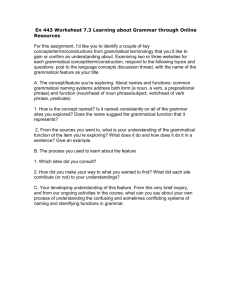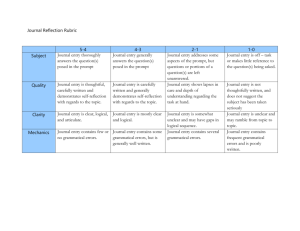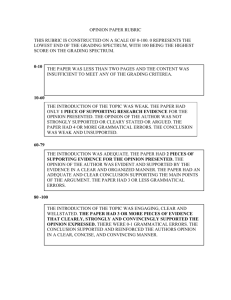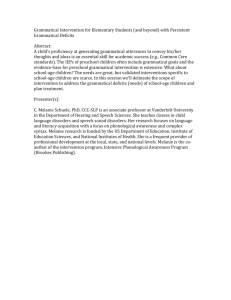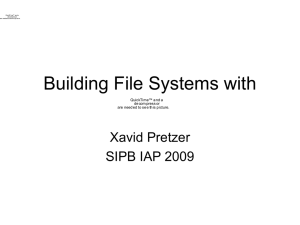ppt
advertisement
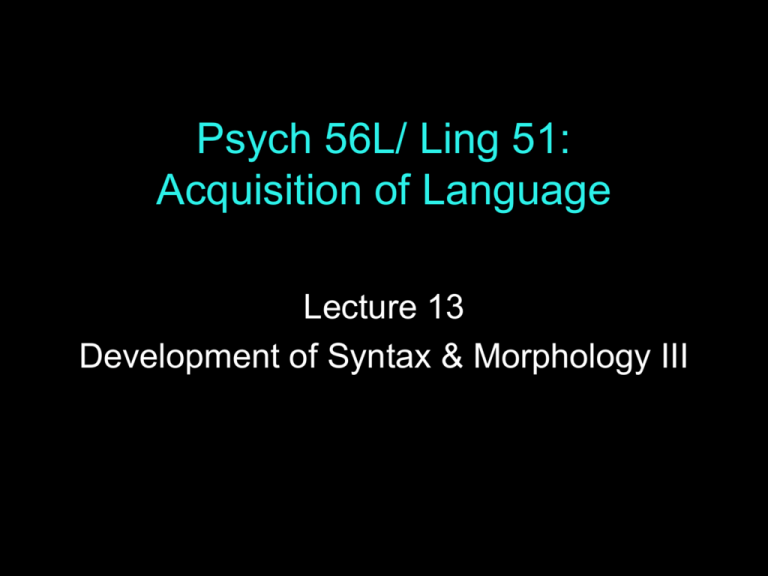
Psych 56L/ Ling 51: Acquisition of Language Lecture 13 Development of Syntax & Morphology III Announcements Announcements here The Nature of Children’s Grammars ??? QuickTi me™ and a decompressor are needed to see thi s pi ctur e. Two Views QuickTi me™ and a decompressor are needed to see thi s pi ctur e. Idea 1: Children’s grammars are pretty much the same as adults’. Children’s less-than-adult performance is due to processing and memory limitations. Idea 2: Children’s grammars are fundamentally different from adults. Only once children learn more do their grammars have the full range of complexity that adult grammars have. The Same? QuickTi me™ and a decompressor are needed to see thi s pi ctur e. Support 1: Children’s word order rules are the same as adult speakers’ word order rules. When children begin to combine words, they do so in consistent ways. Ex: English children consistently put the possessor before the possessed (“my teddy”, not “teddy my”). Support 2: Children’s language comprehension shows evidence of grouping words together into larger units, the same way that adults do. Ex: “the yellow bottle” = one phrase (Noun Phrase) that has smaller groupings --> (the (yellow bottle)). Different? QuickTi me™ and a decompressor are needed to see thi s pi ctur e. Support 1: Children’s initial utterances are compatible with a semantically based grammar that uses only categories that are easily mapped to meaning, like Noun and Verb. Support 2: Children appear to not generalize syntactic rules across all nouns and verbs (the way adults do); instead usage is more tied to individual lexical items. About children’s abstractions Some researchers believe that children recognize the grammatical category Noun (and so that may be similar to adult knowledge), but that they don’t recognize the category Verb. Experimental support: 2-yr-olds use newly learned nonsense nouns in structures with appropriate inflectional morphology, but tend not to do the same with nonsense verbs. Implication A: Young children’s knowledge of how language works with respect to Nouns is not the same as their knowledge of Verbs. About children’s abstractions Some researchers believe that children recognize the grammatical category Noun (and so that may be similar to adult knowledge), but that they don’t recognize the category Verb. Experimental support: 2 yr olds use newly learned nonsense nouns in structures with appropriate inflectional morphology, but tend not to do the same with nonsense verbs. Or…Implication B: using Verbs is harder (more complex sentences, harder meanings), but children’s knowledge of Verbs is fine. Diary studies show children have some flexibility with their first Verb usage. Nature vs. Nurture in Grammar Acquisition QuickTime™ and a decompressor are needed to see this picture. The question “It is obvious that children have some quality of mind that explains why they learn to talk but kittens, for example, do not” - Hoff, p.254 Not obvious what this quality is. Idea 1: Children have specialized (domain-specific) knowledge about how language works. Idea 2: Children’s domain-general cognitive processes allow them to acquire language while a kitten’s do not. Innate Grammatical Knowledge = ? Many human characteristics rely on innate knowledge, such as motor development and vision. Why not language development? Question: Languages of the world are obviously quite different. How can it be that there is innate knowledge of language that ends up with children acquiring these disparate sets of linguistic knowledge? Innate Grammatical Knowledge = ? One answer: Principles & Parameters Theory Children don’t consider all possible systems of communication. Instead they have a bias to consider certain types of hypotheses. For example, they may try to group units into larger units. Within languages, they might realize that word order is (or isn’t) important. Innate Grammatical Knowledge = ? One answer: Principles & Parameters Theory Principles: Apply to all human languages. Ex: Language has hierarchical structure. Smaller units are chunked into larger units. sounds g a b syllables gab lIn words phrases l I n goblin Noun Phrase (NP) Verb Phrase (VP) The sneaky goblin stole the baby S sentences NP VP NP The sneaky goblin stole the baby Innate Grammatical Knowledge = ? One answer: Principles & Parameters Theory Parameters: Constrained variation across languages. Child must learn which option native language uses. Japanese/Navajo S Basic word order: Subject Object Verb Postpositions: Noun Phrase Postposition NP Subject VP NP Verb Object PP NP P Object Postposition Innate Grammatical Knowledge = ? One answer: Principles & Parameters Theory Parameters: Constrained variation across languages. Child must learn which option native language uses. Edo/English Basic word order: Subject Verb Object Prepositions: Preposition Noun Phrase S NP Subject VP Verb NP Object PP P Preposition NP Object Innate Grammatical Knowledge = ? One answer: Principles & Parameters Theory Basic premise: Children listen to linguistic input and decide what ways their native language works. Open question: Exactly what hypotheses children consider (what are the invariant principles and variable parameters). QuickTime™ and a decompressor are needed to see this picture. Innate Grammatical Knowledge = ? One answer: Principles & Parameters Theory Why do children need this kind of head start? Proposal: Input is too impoverished for children to converge on the right language rules without it. Specifically, the input is compatible with other hypotheses about how language could work. This is sometimes called the Poverty of the Stimulus. So, children need something else besides the data in the input to help them rule out these other hypotheses. General cognitive processes = ? Maybe children don’t need domain-specific knowledge to learn language. Maybe they just use the data available to them more cleverly than some researchers think they do (via statistical learning). Support 1: Experimental evidence shows that 8-month-olds can learn distributional regularities in their input (Saffran, Aslin, & Newport 1996). Specifically, they can learn to segment words in an artificial language made up of nonsense words based on the probabilities between syllables. Support 2: Experimental evidence shows that 9-month-olds can apply an abstract pattern learned from the input to new examples (Marcus et al. 1999). Specifically, they can learn to recognize words following an ABA syllable pattern (lapila, doredo) in an artificial language. General cognitive processes = ? Maybe children don’t need domain-specific knowledge to learn language. Maybe they just use the data available to them more cleverly than some researchers think they do (via statistical learning). Support 3: 17-month-olds can learn morphological inflections from distributional cues in the input (Gerken, Wilson, & Lewis 2005). Specifically, Russian noun inflections can be learned if there is sufficient regularity of the inflections on nouns and the inflections are salient cues to the children. Support 4: The same statistical learning processes that allow word segmentation also allow children to identify patterns in musical stimuli (Aslin, Saffran, & Newport 1999). This highlights that these abilities are not specific to language learning. General cognitive processes = ? Maybe children don’t need domain-specific knowledge to learn language. Maybe they just use the data available to them more cleverly than some researchers think they do (via statistical learning). Learning to segment words and identifying appropriate morphology is certainly vital to language acquisition. However, children must also acquire far more complex rules, especially in the syntactic and semantic domain. Ex: Hoggle read a book about ogres. Why is this okay? What did Hoggle read a book about? A book about ogres scared Hoggle. *What did a book about scare Hoggle? …and this is not okay? General cognitive processes = ? Maybe children don’t need domain-specific knowledge to learn language. Maybe they just use the data available to them more cleverly than some researchers think they do (via statistical learning). Learning to segment words and identifying appropriate morphology is certainly vital to language acquisition. However, children must also acquire far more complex rules, especially in the syntactic and semantic domain. So far, it’s hard to tell if these same general cognitive processes (particularly statistical learning) can learn those kinds of rules without some domain-specific knowledge to help them along. About the Input Properties of motherese (helpful input source): (1) very few grammatical errors (good example of correct grammar usage) (2) topics are about the here and now (easier to link words to meanings) (3) adults tend to use gestures to secure children’s attention (easier to link word to meanings) About the Input Properties of motherese (helpful input source): (4) speech is repetitious (easier to remember when you have a short attention span) (5) adults will often expand children’s utterances (learning how to convey the meaning they want by example) “Milk.” “You want some milk?” (6) prosodic features are exaggerated, and pauses tend to occur at phrase boundaries (helping to identify how words cluster together into larger units like phrases) “The brave older sister (pause) went to rescue (pause) her little baby brother Toby.” About the Input But these helpful properties don’t necessarily solve the problem completely. (help solve) How will these properties help children with the more complex aspects of language? It’s unlikely they’ll hear all the complexities they learn (or have them explained by adults) - yet children still learn them. When did the boy say he fell? Ambiguous (2 interpretations) When did the boy say how he fell? Unambiguous (only 1) Children as young as 3 know this, but it’s unlikely to be something encountered in motherese that often…. About the Input However, this doesn’t mean that helping isn’t a good thing. Children who attend day care centers with more one-on-one contact with an adult acquire language more rapidly than children who get less one-on-one adult contact (Hoff 2006). Older children (who receive all of their parents’ child-directed speech) generally develop language earlier than later-born children (who have to share it with their siblings). (HoffGinsberg 1998). Experimental: children who practiced wh-questions learned to produce those wh-questions better (Valian & Lyman 2003). Explicit Feedback in the Input Children make mistakes. Do they get any kind of explicit feedback that would help them correct these mistakes? Yes: Parents often correct for meaning though not for syntactic structure. However, they are more likely to repeat verbatim children’s grammatical sentences than their ungrammatical ones, more likely to ask for clarification of ill-formed sentences, and more likely to reformulate ill-formed sentences. Explicit Feedback in the Input Children make mistakes. Do they get any kind of explicit feedback that would help them correct these mistakes? But… Children cannot rely on parents correcting their grammatical mistakes, since they often don’t correct them. Also, although parents’ differential responses to grammatical vs. ungrammatical sentences exists, children’s memory/attention/cognitive capacity may be too limited to notice this statistical difference or they may simply not know to track this kind of data. Back to the Two Views Idea 1: Children’s grammars are pretty much the same as adults’. Children’s less-than-adult performance is due to processing and memory limitations. Development Trajectory: Children’s general cognitive processing abilities increase with age. There is no major qualitative change to their hypotheses about how language works. Assumptions: Children are equipped with domain-specific knowledge about how language works that gives them a head start in language acquisition. Back to the Two Views Idea 2: Children’s grammars are fundamentally different from adults. Only once children learn more do their grammars have the full range of complexity that adult grammars have. Development Trajectory: Children begin with a more semantically-based idea about how language works, and what looks like a qualitative change to a syntactically-based grammar is really just the result of powerful (domaingeneral) statistical learning mechanisms operating over all the data available. Assumptions: Everything that children learn (and adults know) can be figured out by making the most of the input available. There’s no need for a head start. Back to the Two Three Views Idea 3: Children’s grammars are fundamentally different from adults. Children’s brains mature and then allow the shift to the adult grammar. Development Trajectory: Children begin with a more semantically-based idea about how language works, and qualitatively alter their hypotheses about how language works because their brain matures and they can entertain more complex hypotheses. Assumptions: Children get a head start, but the additional “help” doesn’t come online until children get older. Grammatical Development: Basic Recap It’s still an open question what exactly children know about language at different points in their development - some proposals suggest children’s ideas are fundamentally the same as adults’, while others posit that they are fundamentally different. vs. QuickTime™ and a decompressor are needed to see this picture. QuickTime™ and a decompressor are needed to see this picture. QuickTi me™ and a decompressor are needed to see thi s pi ctur e. QuickTi me™ and a decompressor are needed to see thi s pi ctur e. Questions? QuickTime™ and a decompressor are needed to see this picture.


